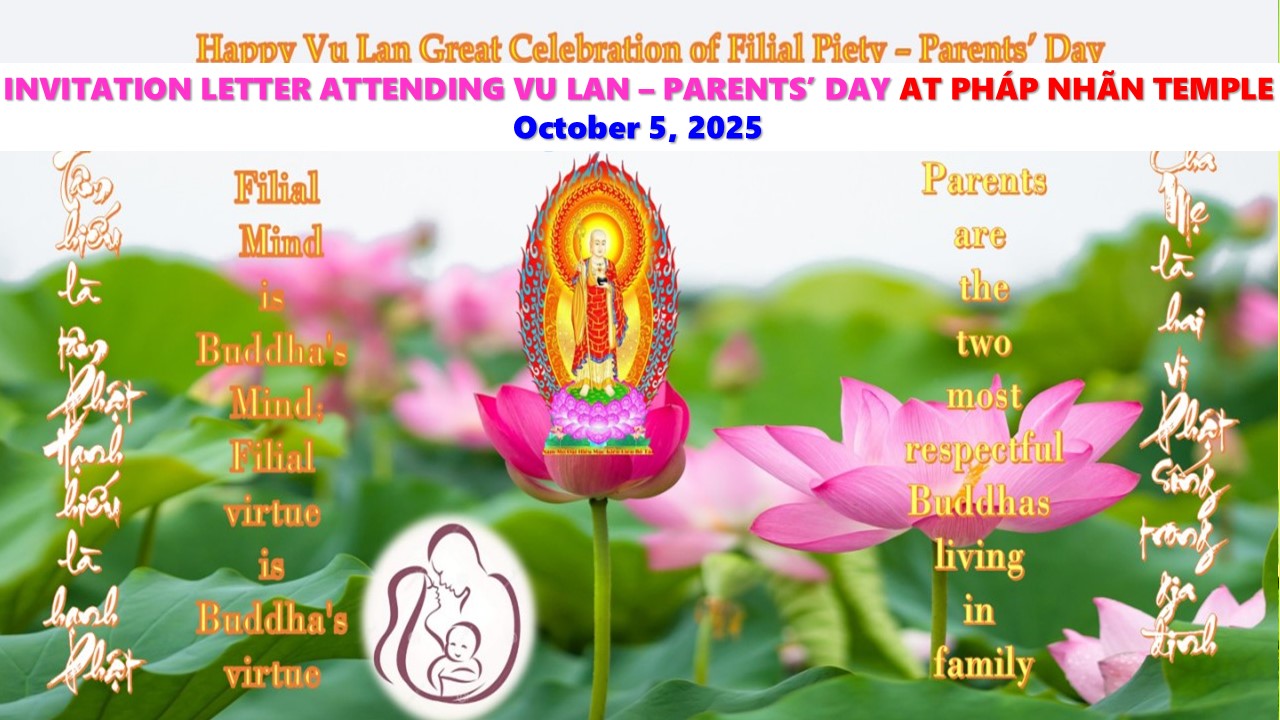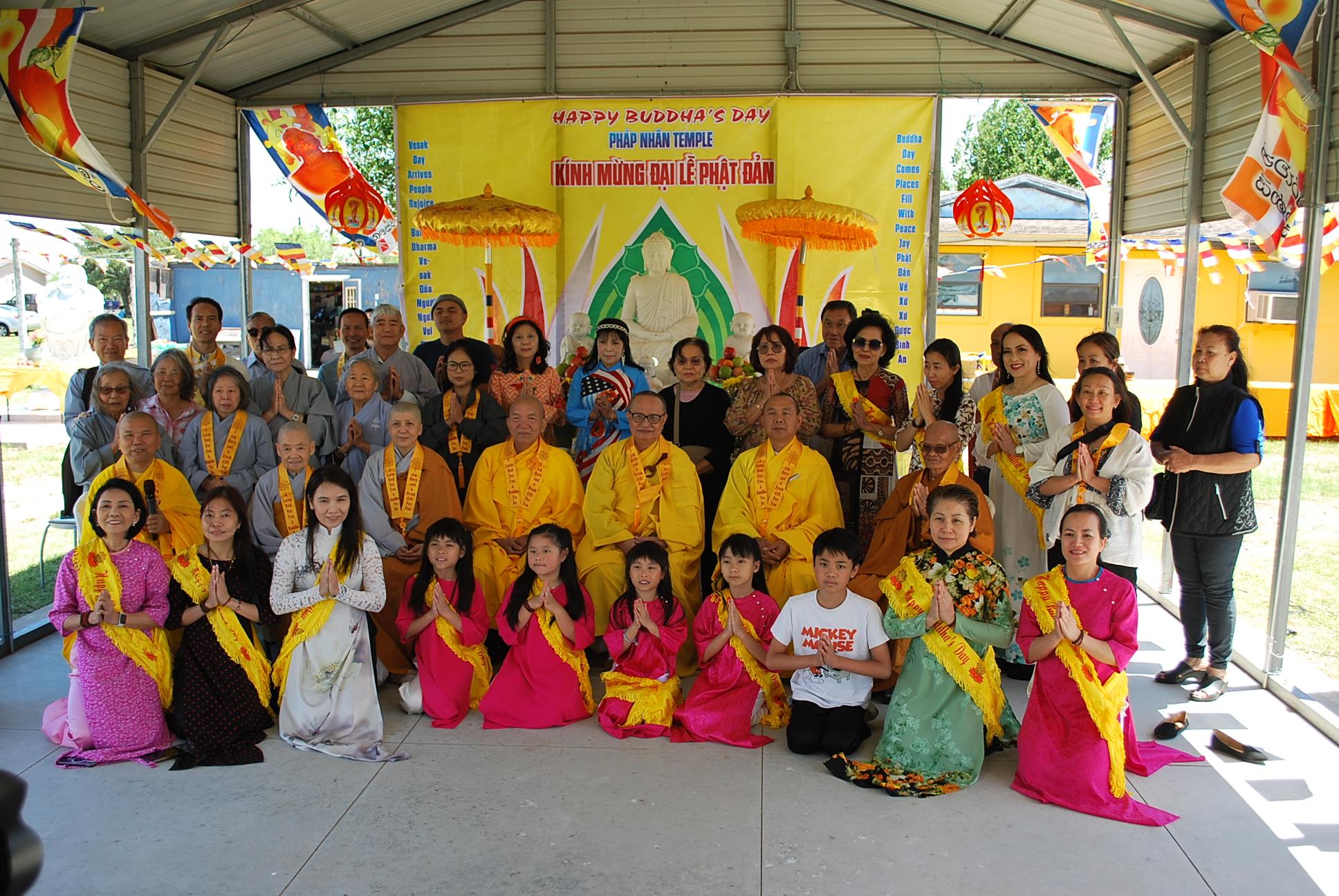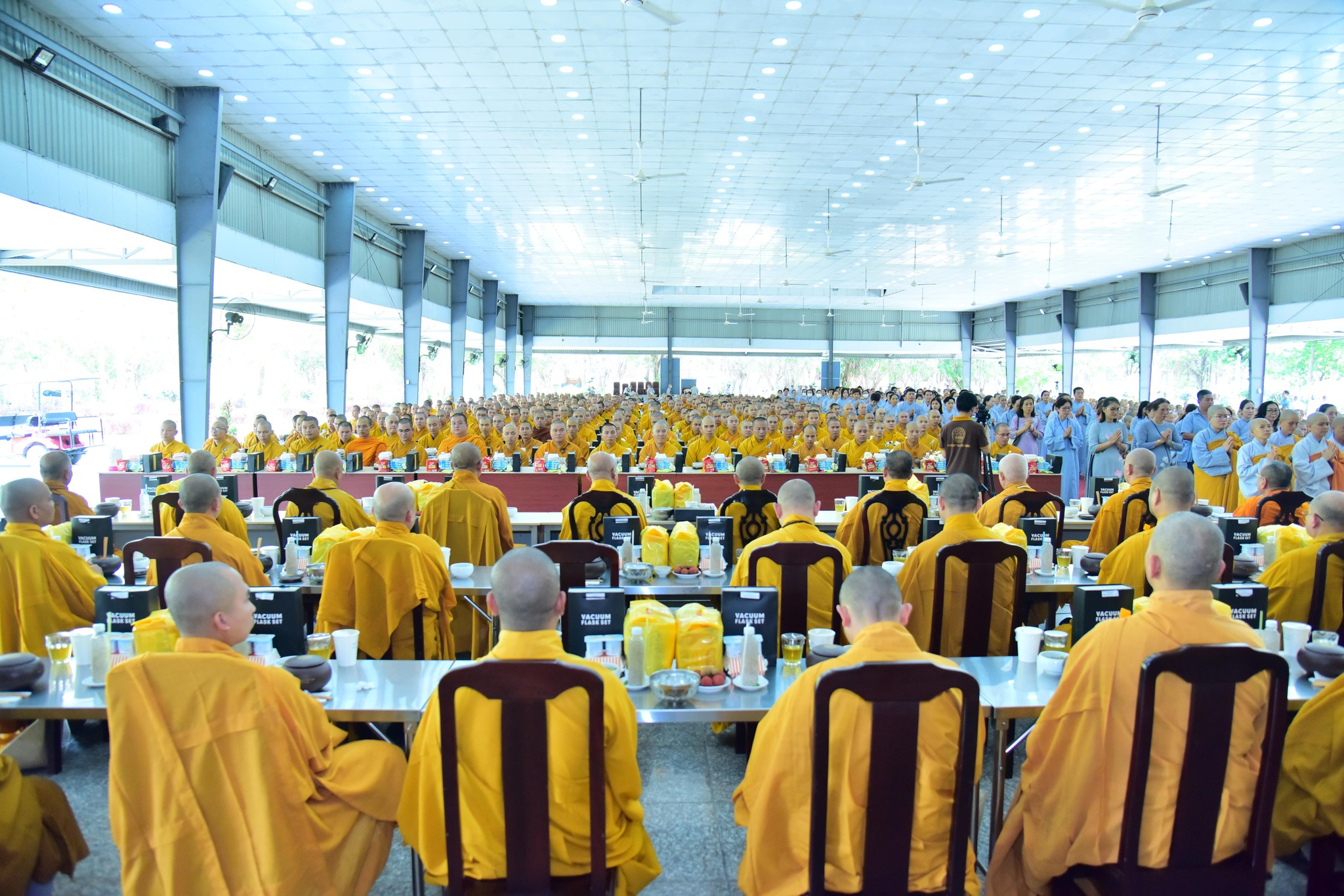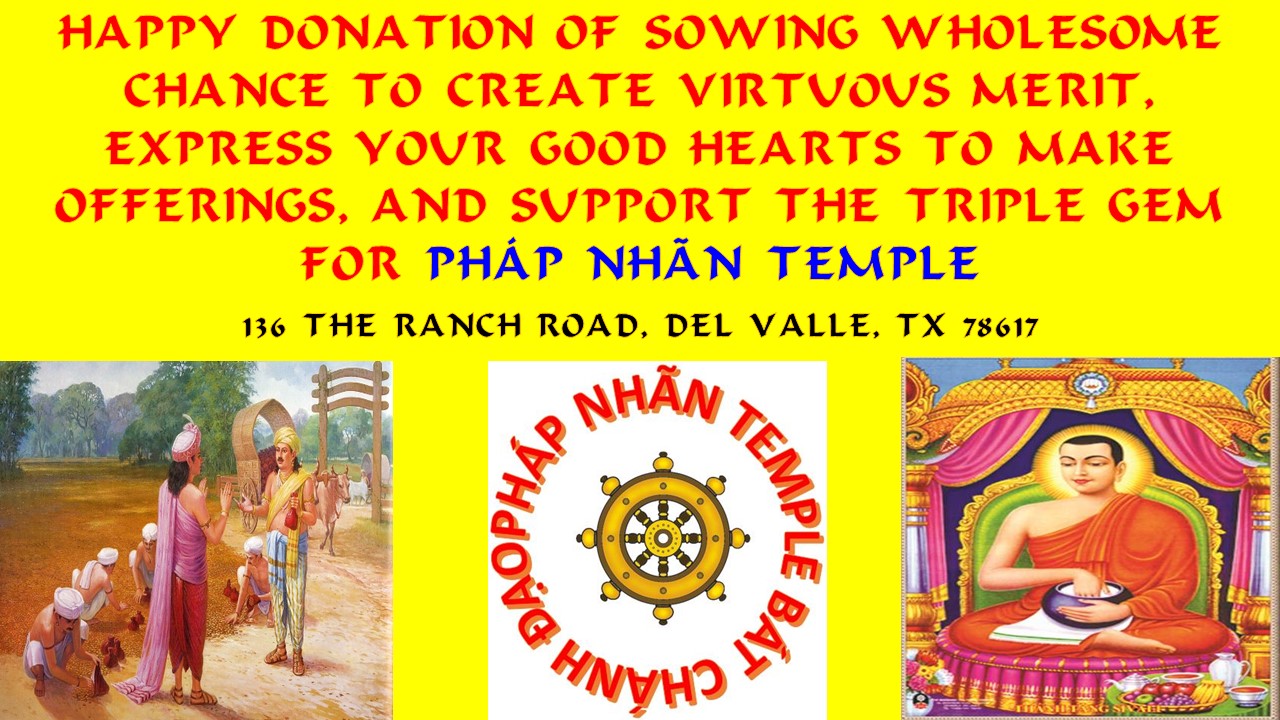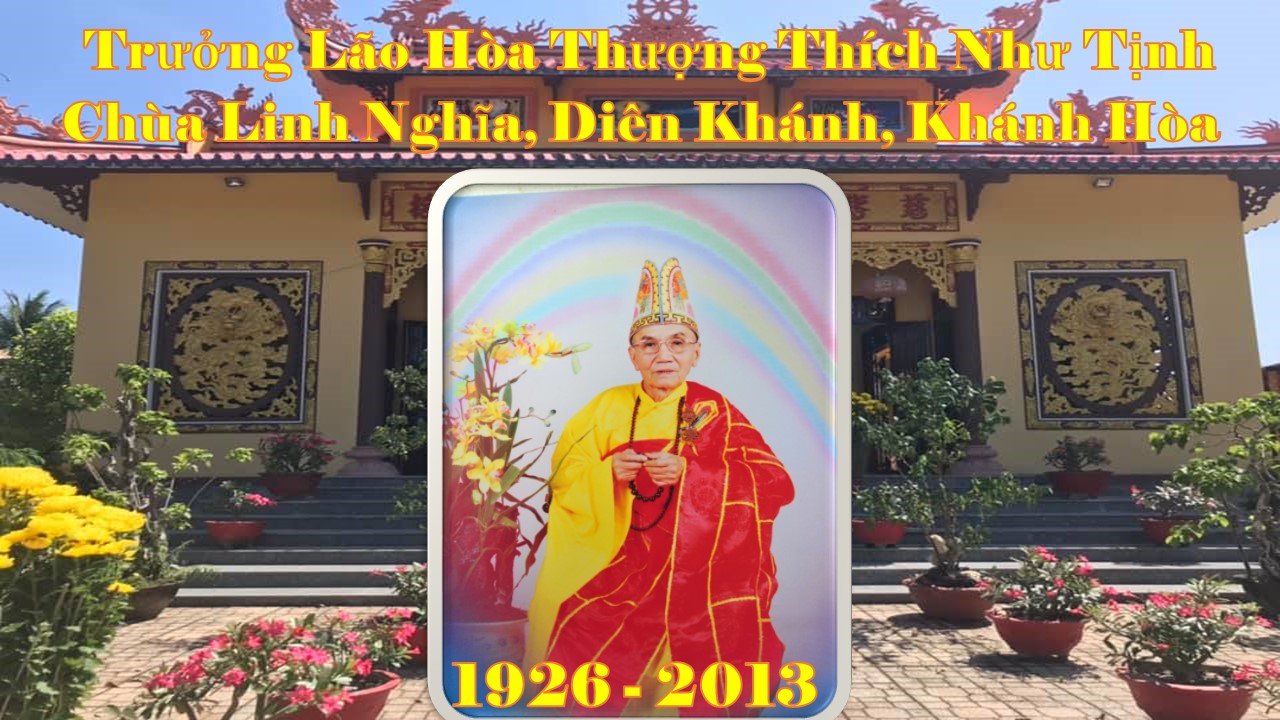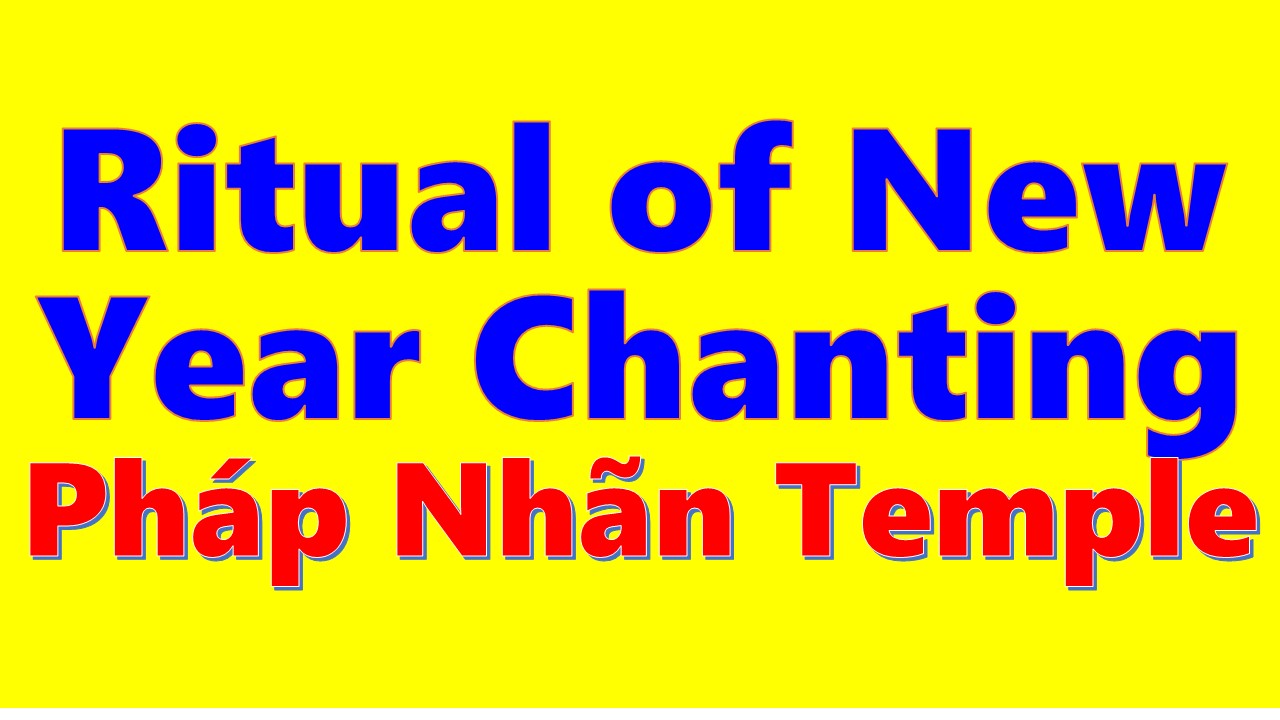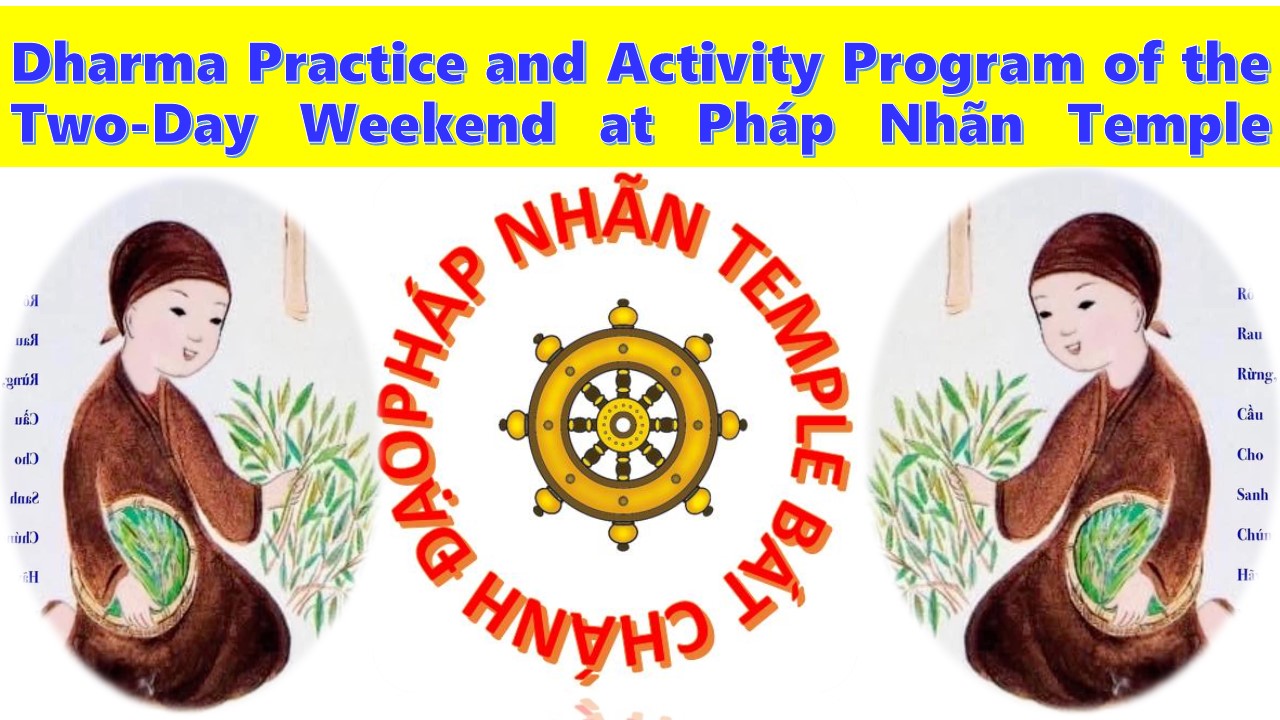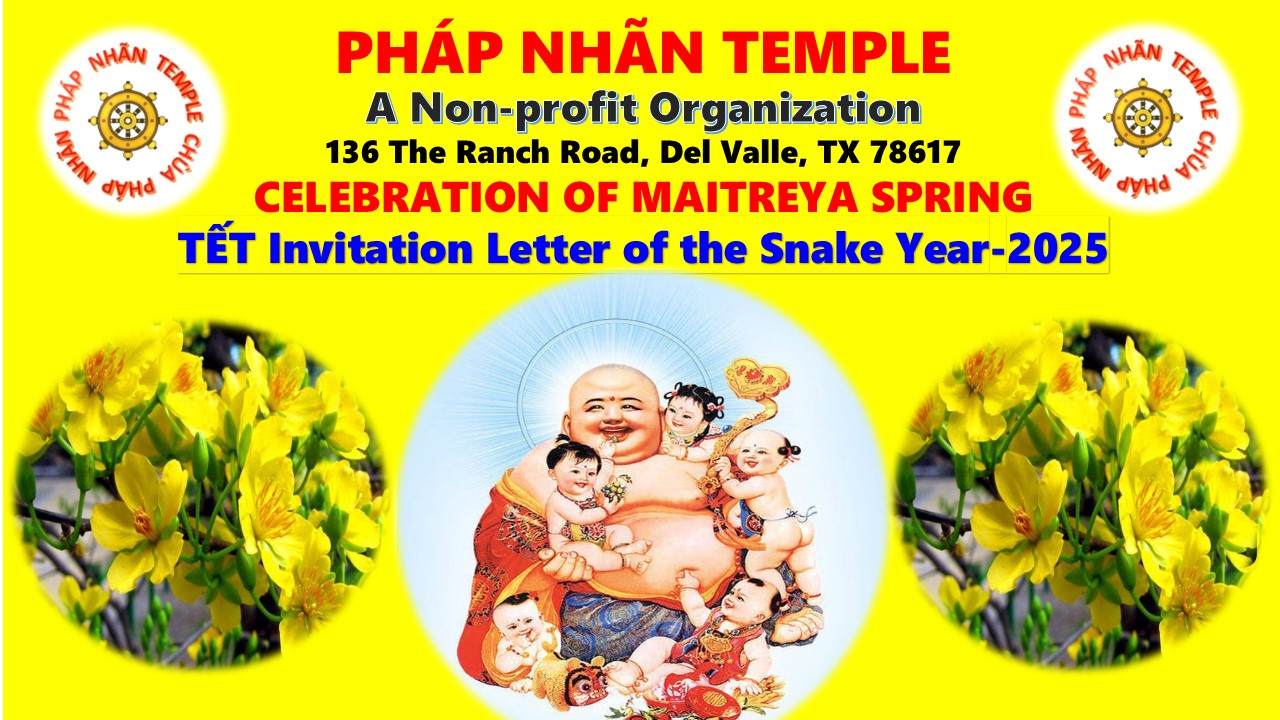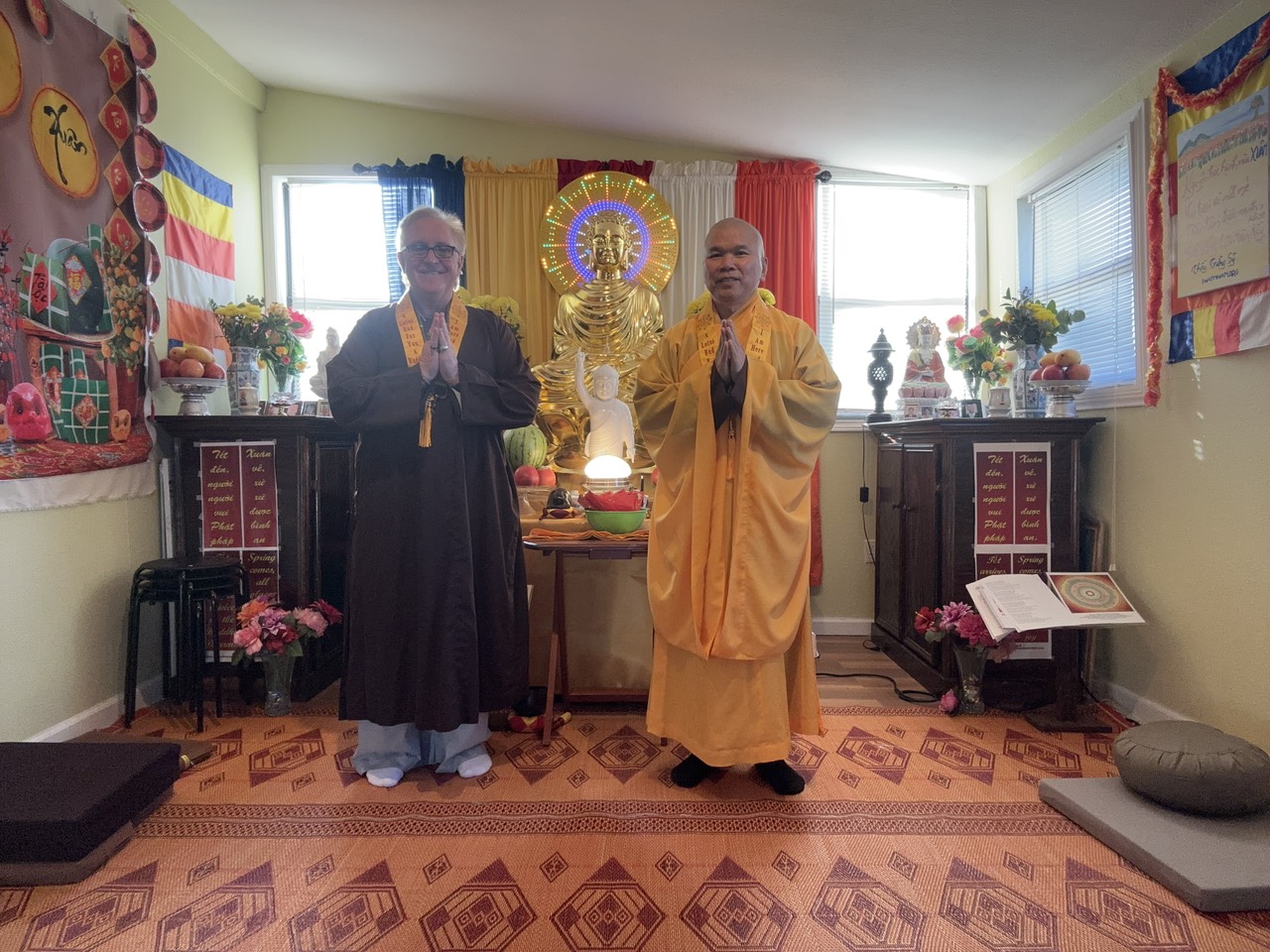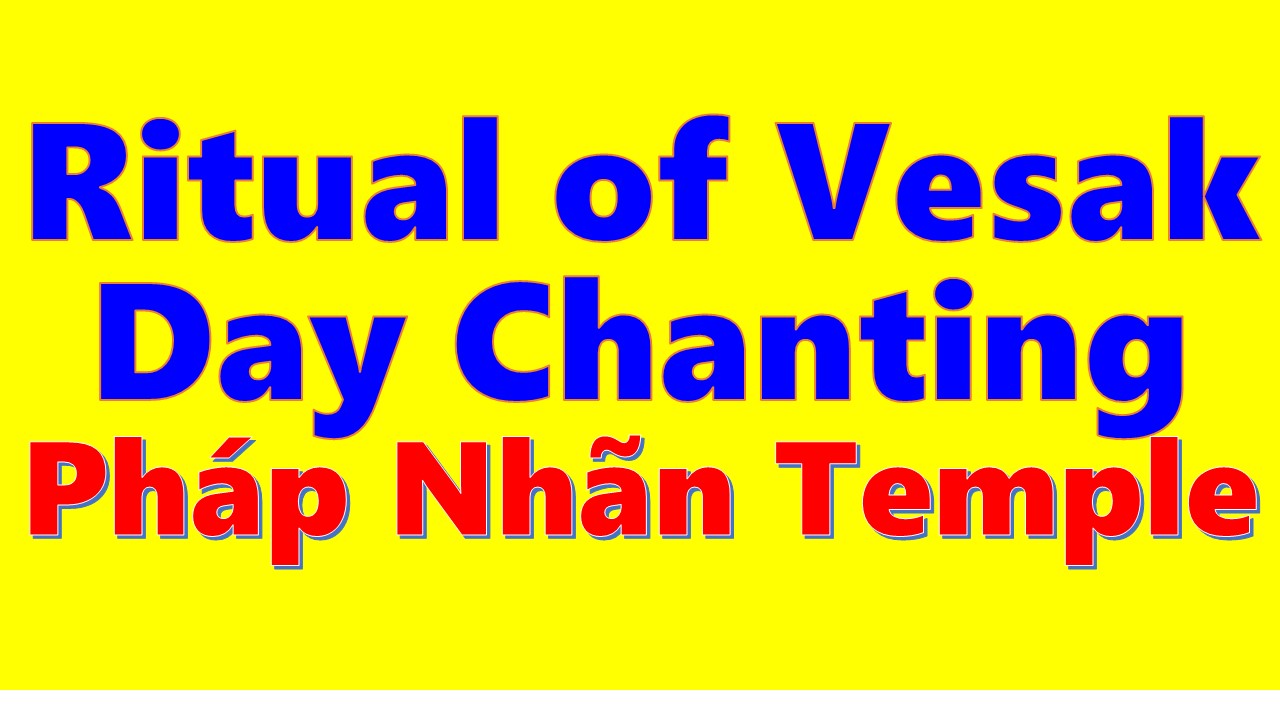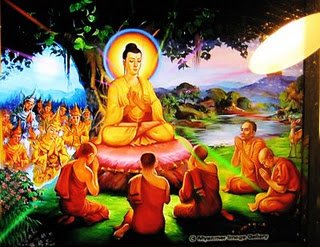
THE RITUAL OF PRACTICING AND BECOMING THE BUDDHA’S CHILDREN
Namo Tassa Bhagavato Arahato Samma SamBuddhassa
(3 times)
Respectfully pay homage to the Buddha: the World-Honored One, the Worthy One, the Exalted One, the Fully Awakened and Enlightened One. (Bell)
Namo The Original Master Sakyamuni Buddhaya
Praising the Buddha
As wonderful as the lotus flower,
As bright as the northern star,
Let us come back and take refuge in
The Master of gods and human beings.
Respectfully Pay Homage to the Triple Gem
The Buddha, who is the fully Awakened and Enlightened One,
Shows the way of peace to living things and living beings,
Has the virtuous, good, and noble signs,
the Buddha’s wisdom and compassion are perfect.
We, disciples of Gautama Buddha, wholeheartedly pay homage to the Buddha forever present in the three lifetimes and ten directions. (One Prostration, Bell)
The Dharma that is the bright way,
Instructs people to escape from the realm of delusion,
Leads us to return to the true home
In order to live a life of awakening.
We, disciples of Gautama Buddha, wholeheartedly pay homage to the Dharma forever present in the three lifetimes and ten directions. (One Prostration, Bell)
The Sangha that is the beautiful Community in harmony
Travels on the joyful path together,
Cultivates to be freed from afflictions
In order to make life beautified.
We, disciples of Gautama Buddha, wholeheartedly pay homage to the Sangha forever present in the three lifetimes and ten directions. (One Prostration, Bell)
VERSE OF REPENTANCE
Sins arising from the mind also need the mind to show repentance.
When the mind is already purified, sins are immediately gone.
The dispelled sins and the purified mind get empty.
It is called the truthfulness of showing repentance.
Namo Bodhisattva Sincerely Finding Repentance
(Repeat x 3, Bell)
Explaining The Meanings of Doing Penance
(This physical body is like a vase that holds many different types of water in life. As an intelligent person, I use this vase to make flowers and to store new water and change the old water by regularly cleaning and tidying it up.
Likewise, as an awakened person, I skillfully use this physical body to beautify life, to develop good things for life, to know how to recognize and repent of mistakes I have made. I vow not to repeat the old mistakes. Aware of that, every day I diligently do good things, say good things, and think about good things to benefit living beings.
The new water in the vase represents mistakes or faults that have been purified, recognized, and transformed. The old water in the vase represents mistakes that have been made.
The vase represents the physical body. Relying on your physical body to benefit oneself and other people right in the present life by applying and practicing to live a life of morality, meditation, and wisdom to benefit the many right in this world.)
Disciples repeat after the Master’s instructions.
My name is ……..
I vow my whole life to take refuge in the Buddha, the One who shows me the way of loving-kindness, compassion, and wisdom in my lifetime.
I vow my whole life to take refuge in the Dharma, the way of practicing peace, joy, happiness, understanding, and love for the many right in the present life.
I vow my whole life to take refuge in the Sangha, the Community of cultivated people who vow to lead their lives of ethics, harmony, and awareness to themselves and to others right here and right now in the present life. (Bell)
Disciples repeat after the Master’s instructions.
My name is ….
I take refuge in the Buddha. I vow my whole life not to take refuge in Brahma, gods, demons, and evil things.” (Bell)
Disciples repeat after the Master’s instructions.
My name is ….
I take refuge in the Dharma. I vow my whole life not to take refuge in paganism and heresy. (Bell)
Disciples repeat after the Master’s instructions.
My name is ………
I take refuge in the Sangha. I vow my whole life not to take refuge in wrong teachers, wrong teachings, bad people, and bad environments. (Bell)
Disciples repeat after the Master’s instructions.
I have already taken refuge in the Buddha. I don’t fear falling into a realm of hell. (Bell)
Disciples repeat after the Master’s instructions.
I have already taken refuge in the Dharma. I don’t fear falling into a realm of a hungry ghost. (Bell)
Disciples repeat after the Master’s instructions.
I have already taken refuge in the Sangha. I don’t fear falling into a realm of an animal. (Bell)
Disciples repeat after the Master’s instructions.
I have just taken my vow to take refuge in the Triple Gem.
I have been given the name “……………” by Master.
Disciples repeat after the Master’s instructions.
May the World-Honored One happily accept me as a monastic disciple. From now until my whole life, I am determined to take refuge in the Buddha, the Dharma, and the Sangha, and I take the vow to practice the Ten Methods of Mindfulness Trainings fully:
THE MASTER TRANSMITS THE TEN METHODS
OF MINDFULNESS TRAININGS TO DISCIPLES
THE FIRST METHOD OF MINDFULNESS TRAINING
Protecting the Lives of Sentient Beings
Disciples repeat after the Master’s instructions.
Being aware that the sufferings caused by killing, I would like to follow the virtues of great loving-kindness and compassion to protect the lives of all people and all beings. I vow not to kill the lives of beings, disapprove of killing and not let others kill, whether in my mind or in my daily way of life.
I vow not to kill myself, not to kill sentient beings by myself, not to tell people to kill sentient beings, and not to see whoever kills sentient beings that I rejoice.
The Master asks:
Dear Dharma Sister and Brother,
Are you ready and happy to accept, practice, and apply the first method of mindfulness training in your daily life?
Disciples make the vow to practice:
Namo Buddhaya. Yes, I am.
When you hear the sound of the bell, please breathe in and out mindfully and consciously. (Bell)
THE SECOND METHOD OF MINDFULNESS TRAINING
Respecting Private Property of Others
Disciples repeat after the Master’s instructions.
Being aware of the sufferings caused by deception, robbery, and social injustice, I would like to learn the virtues of great loving-kindness and compassion to bring the joy of life and well-being to everyone and everything, to share my time and capacity to those in need. I vow not to take any property of individuals or collectives to make my own property. I vow to respect the private possessions of others, and also vow to prevent others from dishonestly hoarding and enriching them on the sufferings of people and of all beings.
The Master asks:
Dear Dharma Sister and Brother,
Are you ready and happy to accept, practice, and apply the second method of mindfulness training in your daily life?
Disciples make the vow to practice:
Namo Buddhaya. Yes, I am.
When you hear the sound of the bell, please breathe in and out mindfully and consciously. (Bell)
THE THIRD METHOD OF MINDFULNESS TRAINING
Protecting the Virtue and Chastity of Practitioner
Disciples repeat after the Master’s instructions.
Being aware that the practitioner’s ideal can only be accomplished with the complete removal of attachments and ties to sensual love, I vow to keep myself so pure, protect myself with my virtuous life and wholeheartedly protect the chastity of others. I know that the act of sexual lust not only destroys my life and my monastic will, but also harms the lives of others, and prevents me from fulfilling my ideal of saving sentient beings. For lay people, when they grow up, they get married, but for those who have the will to leave their secular life for monastic life live a simple and free life, are not being involved in a family, are not bound by the family life, and spend a lot of time learning and practicing the Buddha Dharma to benefit many people.
The Master asks:
Dear Dharma Sister and Brother,
Are you ready and happy to accept, practice, and apply the third method of mindfulness training in your daily life?
Disciples make the vow to practice:
Namo Buddhaya. Yes, I am.
When you hear the sound of the bell, please breathe in and out mindfully and consciously. (Bell)
THE FOURTH METHOD OF MINDFULNESS TRAINING
Practicing Right Speech and Listening
Disciples repeat after the Master’s instructions.
Being aware that suffering and unhappiness are caused by speech of lacking mindfulness, I vow to learn the virtues of right speech and listening in order to offer other people joy and help them alleviate suffering. Knowing that the right speech can bring happiness to people, and wrong speech can cause suffering for them, I vow to only say the right speech so that I can create more confidence, happiness, and prestige for many people.
I vow not to say something wrong with the truth, not to say words that cause divisions and hatred. I vow not to spread the news that I am not sure is true, not to criticize and condemn things I do not know well. I vow to practice listening with compassion in order to be able to understand the sufferings and difficulties of others and to alleviate their sufferings. I vow not to say the discordant things that can cause divisions and disruptions in the community of my Dharma learning and cultivation. I vow to practice the right speech to build sisterhood and brotherhood in the spirits of harmony, reconciliation, solidarity, mutual assistance, mutual affection, mutual love, and mutual respect.
The Master asks:
Dear Dharma Sister and Brother,
Are you ready and happy to accept, practice, and apply the fourth method of mindfulness training in your daily life?
Disciples make the vow to practice:
Namo Buddhaya. Yes, I am.
When you hear the sound of the bell, please breathe in and out mindfully and consciously. (Bell)
THE FIFTH METHOD OF MINDFULNESS TRAINING
Protecting and nourishing my body and mind by not using intoxicants, drugs, and not consuming toxic products
Disciples repeat after the Master’s instructions.
Being aware that the suffering and unhappiness caused by the use of intoxicants, drugs, and toxins and prevent me from mastering my body and mind, I vow to practice mindfulness in eating, drinking, and consuming healthy things to bring peace and joy to the body and mind. I vow not to use intoxicants, drugs, not to eat, drink, and not to consume toxic products including books, magazines, and films containing violence, fear, lust, and hatred.
The Master asks:
Dear Dharma Sister and Brother,
Are you ready and happy to accept, practice, and apply the fifth method of mindfulness training in your daily life?
Disciples make the vow to practice:
Namo Buddhaya. Yes, I am.
When you hear the sound of the bell, please breathe in and out mindfully and consciously. (Bell)
THE SIXTH METHOD OF MINDFULNESS TRAINING
Not Using Cosmetics and Jewelry
Disciples repeat after the Master’s instructions.
Being aware of the true beauty of a practitioner is the nature of stability and freedom, I vow every day to beautify the Sangha and me by practicing mindfulness, namely the observance of the precepts, disciplines, and dignities in everyday life. I know the cosmetics and jewelry that people use can only bring fake glamor to the outside, and only have the effect of causing depravities and entanglements, so I vow to live a simple, neat, and clean life in the way of my dress. I vow not to use kinds of perfumes, lipstick, cosmetics, and other jewelry.
The Master asks:
Dear Dharma Sister and Brother,
Are you ready and happy to accept, practice, and apply the sixth method of mindfulness training in your daily life?
Disciples make the vow to practice:
Namo Buddhaya. Yes, I am.
When you hear the sound of the bell, please breathe in and out mindfully and consciously. (Bell)
THE SEVENTH METHOD OF MINDFULNESS TRAINING
Not Entangled In Secular Pastimes
Disciples repeat after the Master’s instructions.
Being aware not to join and cling to styles of secular entertainments and pastimes, such as online electronic games, debauched and violent films, news, stories, books, newspapers, and songs of deep sorrow and grief, and vice versa, I am aware to contact and learn about educational, moral, and scientific films, news, stories, books, newspapers, songs of meditation and the Dharma. So I try to spend a lot of time studying, applying, and practicing the Buddhadharma in my daily life to benefit myself and other people right here and right now in the present life.
The Master asks:
Dear Dharma Sister and Brother.
Are you ready and happy to accept, practice, and apply the seventh method of mindfulness training in your daily life?
Disciples make the vow to practice:
Namo Buddhaya. Yes, I am.
When you hear the sound of the bell, please breathe in and out mindfully and consciously. (Bell)
THE EIGHTH METHOD OF MINDFULNESS TRAINING
Not Living A Luxurious, Lavish, and Material Life
Disciples repeat after the Master’s instructions.
As a good practitioner, I am aware that living in luxurious, lavish, and material conditions will easily arouse craving, arrogance, and sensual desire. I vow my whole life to live only a life of simpleness, little desire, knowing enough, and treasuring what I have. I vow not to sit and lie on gorgeous chairs and beds, not to use silk, brocade, satin, shiny vehicles, and luxurious houses.
The Master asks:
Dear Dharma Sister and Brother,
Are you ready and happy to accept, practice, and apply the eighth method of mindfulness training in your daily life?
Disciples make the vow to practice:
Namo Buddhaya. Yes, I am.
When you hear the sound of the bell, please breathe in and out mindfully and consciously. (Bell)
THE NINTH METHOD OF MINDFULNESS TRAINING
Eating Vegetarian Food and Not Eating
Outside of The Sangha’s Meals
Disciples repeat after the Master’s instructions.
In order to stay healthy and prevent disease effectively, I vow not to eat fish and types of animal meats. Being aware that the necessities of maintaining health, living in harmony with the Sangha, nurturing and developing loving-kindness and compassion, I vow my whole life to eat vegetarian food and not to eat outside of the Sangha’s meals, except when being sick.
The Master asks:
Dear Dharma Sister and Brother,
Are you ready and happy to accept, practice, and apply the ninth method of mindfulness training in your daily life?
Disciples make the vow to practice:
Namo Buddhaya. Yes, I am.
When you hear the sound of the bell, please breathe in and out mindfully and consciously. (Bell)
THE TENTH METHOD OF MINDFULNESS TRAINING
Not Accumulating Money, Wealth, and Jewels
Disciples repeat after the Master’s instructions.
Being aware that the happiness of the practitioner is made of steady and relaxed cultivation materials, I vow not to let money, jewels, and wealth interfere with my spiritual path. I vow not to accumulate money, wealth, and jewels, not to look for happiness in the accumulation of money, wealth, and jewels because they cannot guarantee and protect my safety and security.
Being well aware of that, as a good practitioner, I am determined to find true happiness in Dharma learning, Dharma practice, Dharma joy, and Dharma happiness.
The Master asks:
Dear Dharma Sister and Brother,
Are you ready and happy to accept, practice, and apply the tenth method of mindfulness training in your daily life?
Disciples make the vow to practice:
Namo Buddhaya. Yes, I am.
When you hear the sound of the bell, please breathe in and out mindfully and consciously. (Bell)
Some Words of Encouragement
The Ten Methods of Mindfulness Training have been just transmitted to you. From now until your whole life, you are the well-trained disciple of the Buddha. Every half a month at least a few times, you spend your proper reading, learning, practicing, and think deeply about the Buddha’s teachings to benefit yourself and other people right here and right now in the present life.
Time is like a shuttle, like a flying arrow. It never stops. Health will be weaker and weaker. Life will be shorter and shorter. Try to practice the Buddhadharma very well to benefit living beings.
If you study the Dharma thoroughly, fluently, and maturely, in the near future, you will become a well-dharma teacher with the ability to guide and propagate the Buddhadharma to people everywhere.
The future is right in the present. Now, we have been practicing the Buddhadharma very well, peacefulness and happiness are capable of permeating and cooling the whole body and mind.
Namo The Original Master Sakyamuni Buddhaya.
SHARING THE MERIT
Reciting the trainings, practicing the way of awareness gives rise to benefits without limit. We vow to share the fruits with all beings. We vow to offer tribute to parents, teachers, friends, and numerous beings who give guidance and support along the path. May the merit of this practice benefit all beings and bring peace. (Bell)
Express diligent vows and pay thankful respects to the Triple Gem
We, the disciples of Gautama Buddha, are always aware of ourselves by day and by night, constantly practice and recollect the light of the Buddha. Namo Buddhaya. (Bell, one prostration)
We, the disciples of Gautama Buddha, are always aware of ourselves by day and by night, constantly practice and recollect the light of the Dharma. Namo Dharmaya. (Bell, one prostration)
We, the disciples of Gautama Buddha, are always aware of ourselves by day and by night, constantly practice and recollect the light of the Sangha. Namo Sanghaya. (Bell, one prostration)
May we be well,
May we be happy
May we be healthy
May we be peaceful
May we be free from suffering, greed, anger, delusion, hatred, violence, ignorance, etc.
May the Buddha and Bodhisattvas bless and protect all anytime and anywhere.
Sadhu, lành thay, well-done, and excellent.
(Bell, Bell, Bell)
By Venerable Master Thích Trừng Sỹ
Trao Truyền và Tiếp Nhận Mười Phương Pháp Thực Tập Chánh Niệm Từ Tam Bảo


